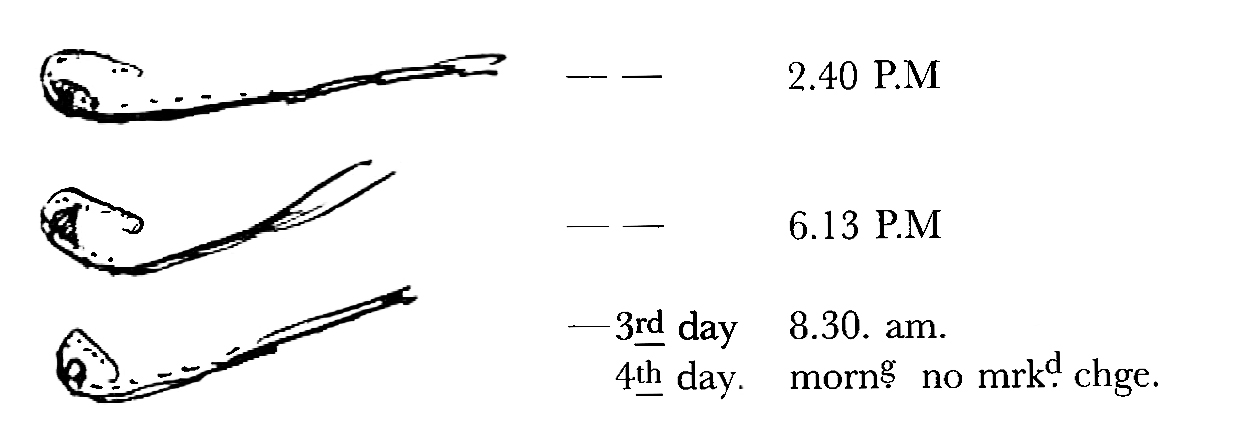From Daniel Oliver 25 September 1860
Kew. W.
25th. IX/60
Dear Sir,
My results so far with pure gum quite support your opinion.1 Yesterdy. morng. 9.25. a drop was put on a leaf of D. spathulata (a leaf of wh. I enclose) at 2.10 P.M. no marked change,—proby. some inflection of inner glands,—but the marginal patent or recurved. 5.55. do. this day (Tuesdy.) 8.56 AM & 5.48 P.M. No material change as yet. The plant looks unhealthy.
Another drop was placed on a leaf of D rotundifolia? 2.13. P.M. (Yestery.)— No marked result this eveng.
I must try the old gum again. I have not burnt it yet. Besides Im not sure if we used it (the new) in equally strong solution. I intend still trying it.
We have another Drosera I dont know the species,—(I understand Australian) with narrow linear leaves Its rate of incurving some days ago over a fly was as follows


I quite look to working up one or two spinous Floras 2 I think of, as one, the Flora (Florula!) of Aden upon wh. Dr. Anderson is just now engaged here.3 It is to appear in a supplt. to the Linn: Journal It is a very spiny Flora. Then Delile, for Egypt.4 perhaps Kelaart, for Gibraltar.5 Munby’s list for Algeria—6 No. West India.—& Some part of Tropical Australia or Mexico would be important. To contrast I would take our own Flora,—that of Arctic circle (easy)—upon wh. Dr. H. has much material for the Linn Trans. (it will not appear tho‘ I doubt till towds. close of next year)7—V. Diemen’s Land. (J.D.H.)8 So. United States (Chapman).9 Before setting seriously to work upon it I should like to complete a little task I have in hand among the Aurantiaceae wh. I am trying (apart from Citrus) to rearrange.—10
The various sorts of spinosity ought to be separately tabulated,—whether true spines,—epidermal (prickles) & leaf appendages,—hardwd. bracts, &c Often it will be difficult to draw the line between spinose & spineless species,—as among Thistles, Dipsacus, &c. &c.
Apropos of Drosera see a footnote in Dr. Bromfield’s ’Flora Vectensis‘ p. 56—“The glands x x x x curving eventually over the flies x x x ensnared by their clammy exudation, but never, so far as I could observe, assisting primarily in their capture by any sudden contraction as in Dionæa muscipula”11
I put a bit of paper in daubed with old gum,— I did not perceive animal odour on burning a piece.
Very faithfully yours | Danl. Oliver. Jr
I doubt if we get good seed this autumn from over 3 or 4 of the isosceles beds!12
CD annotations
Please cite as “DCP-LETT-2927,” in Ɛpsilon: The Charles Darwin Collection accessed on